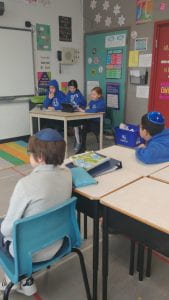Shalom shalom,
Few weeks before the internet and virtual learning, having the end of the year in mind, in grade 8 we started talking about having a project that will present the experience of learning Hebrew at OJCS.
In the last week, it was the main point of focus for Grade 8. Next week the students will share their videos after they wrote the base text for it this week. Reading the student’s notes and ideas for this project can give some understanding of the love they have for past teachers, together with their appreciation and feeling of accomplishment.
Stay tuned, for next week you will actually listen and see it in Hebrew videos of course : )
Here is how we framed the project (Hebrew translation will follow):
The Hebrew language is one of the oldest, ancient and complicated languages that exist, according to traditions, academic scholars and linguists experts, it has been spoken for thousands of years.
After the destruction of the Second Temple of Israel and the exodus of the Israelites into exile, Jews all over the world stopped using Hebrew as a day-to-day language and moved to the local languages in the locations where they were. For thousands of years Hebrew maintained its place as a religious language in which holy books are written, and prayers are held but it was not spoken otherwise
The return of the Jewish people to the Land of Israel after the Holocaust and World War II marks an important turning point. From that moment on, the Hebrew language became once more the spoken language of the Jewish people living in Zion. The Hebrew language has been renewed. Today many words from the Torah are spoken in everyday life, along with new words that gap the need to bring Hebrew into the modern era.
This change also had a major impact on Jewish education around the world. In our school, as in other Jewish schools, Hebrew is learned as a content topic by its own right (beyond Torah and Jewish studies). It strengthens our local Jewish community’s connection with Jewish communities around the world, with our history and heritage, and with the State of Israel. There are other benefits to learning the Hebrew language.
Now that you have completed eight years of learning Hebrew, it is time to summarize your learning experience by answering these three questions:
How did you learn Hebrew in different ages and classes?
הַסְבִּירוּ אֵיךְ (כֵּיצַד) לְמַדְתֶּם עִבְרִית בַּכִּתּוֹת הַשּׁוֹנוֹת לָאֹרֶךְ הַשָּׁנִים
How knowing Hebrew could help you in the future?
הַסְבִּירוּ כֵּיצַד יְדִיעַת הַשָּׂפָה הָעִבְרִית תַּעֲזֹר לָכֶם בַּהֹוֶה וּבֶעָתִיד
What would you change in it (for future learners)? What could be done better? What was great?
הַאִם הָיִית מִשְׁנֶה מַשֶּׁהוּ בַּדֶּרֶךְ שֶׁלּוֹמְדִים עִבְרִית בְּבֵית סִפְרֵנוּ? אִם כֵּן מָה הָיִית מְשַׁנֶּה?
השפה העברית היא אחת השפות העתיקות ומסובכות ביותר שיש, אנשי דת, חוקרים אקדמיים ובלשנים מאמינים שהשפה העברית מדוברת מזה אלפי שנים.
לאחר חורבן בית המקדש השני ויציאת בני-ישראל אל הגלות, יהודים בכל העולם הפסיקו להשתמש בשפה העברית כשפת יום יום ועברו לשפות המקומיות בארצות שבהם חיו. במשך 2000 שנים מקומה של השפה העברית נשמר כשפה דתית שבה כתובים ספרי קודש, ובעזרתה מתפללים.
חזרתו של העם היהודי לארץ ישראל לאחר השואה ומלחמת העולם השניה, מסמלת נקודת תפנית חשובה. מרגע זה והלאה השפה חזרה להיות השפה המדוברת של העם היהודי החי בציון. השפה העברית חודשה, מילים רבות מכתבי הקודש מדוברות בשפת היום יום, יחד עם מילים חדשות שעונות על הצורך לחסר את העברית לתקופה המודרנית.
שינוי זה גם השפיע רבות על החינוך היהודי ברחבי העולם, בבית ספרנו, כמו בבתי ספר יהודיים אחרים, מלמדים את השפה העברית כנושא תוכן בפני עצמו (מעבר ללימודי קודש, ולימודי יהדות), על מנת לחזק את הקשר של הקהילה היהודית המקומית לכלל עם ישראל, למורשת שלנו ולמדינת ישראל.

